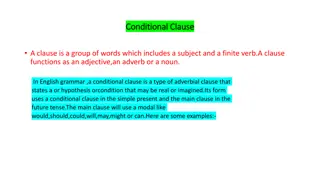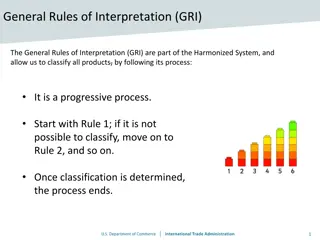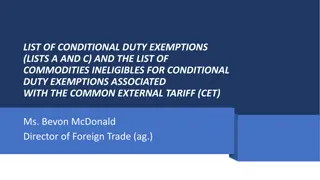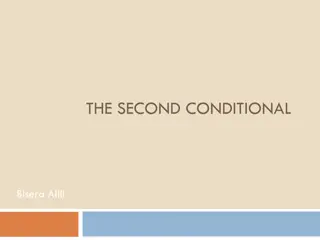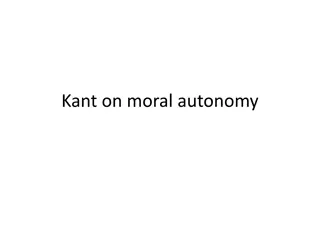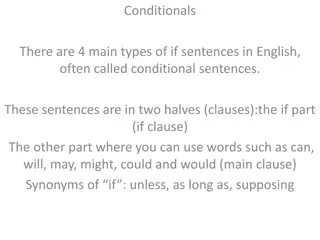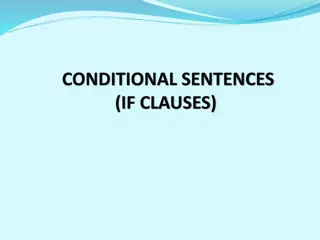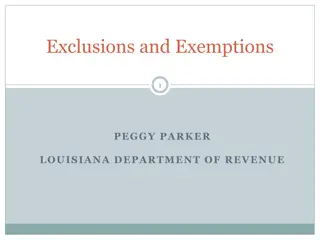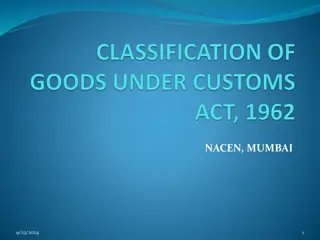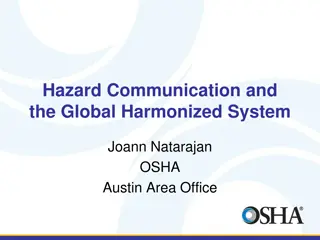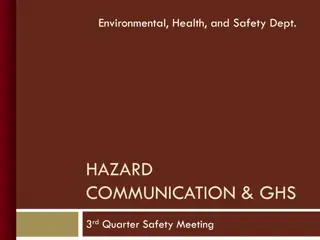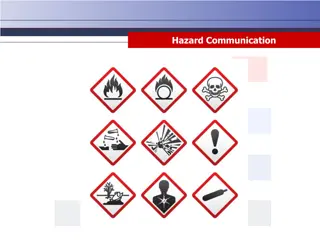Understanding Conditional Duty Exemptions and the Harmonized System
This information delves into the concept of conditional duty exemptions associated with the Common External Tariff (CET) and the Harmonized System (HS). It explains the structure of the Schedule of Rates based on the HS, the application of duty rates in CARICOM, and the lists of items ineligible for duty exemption. Additionally, it outlines the rules governing the application of duty exemptions for imported goods and the classification system used by over 180 countries. The article offers insights into how goods may be admitted into a Member State free of import duty or at a reduced rate, subject to approval by the relevant Competent Authority.
Download Presentation

Please find below an Image/Link to download the presentation.
The content on the website is provided AS IS for your information and personal use only. It may not be sold, licensed, or shared on other websites without obtaining consent from the author. Download presentation by click this link. If you encounter any issues during the download, it is possible that the publisher has removed the file from their server.
E N D
Presentation Transcript
LIST OF CONDITIONAL DUTY EXEMPTIONS (LISTS A AND C) AND THE LIST OF COMMODITIES INELIGIBLES FOR CONDITIONAL DUTY EXEMPTIONS ASSOCIATED WITH THE COMMON EXTERNAL TARIFF (CET) Ms. Bevon McDonald Director of Foreign Trade (ag.)
The Harmonized System: Classification structure of the Schedule of Rates is based on the 2017 6thedition Harmonized Commodity Description and Coding System, commonly known as the Harmonized System (HS) which is administered by the World Customs Organisation (WCO). Statistical Classification Numbers are based on the Standard International Trade Classification, Fourth Revision. Is a multipurpose 6-digit international commodity classification system used by governments, international organizations, and private sector, as a basis for customs tariffs, international trade statistics, freight rates and production statistics. It is used worldwide by over 180 countries, representing 98% of goods in international trade. Guyana currently uses HS 2017 and will be moving to HS2022 from July 1st.
The Harmonized System contd Rates of duty shown in the Schedule of Rates is applicable to imports from third countries, into CARICOM as well as to goods traded among CARICOM Member States which do not qualify for Community treatment. In the Schedule of Rates, the letters A, C and D appear in the column headed rate of duty and signify that reference should be made to one of the Lists, A, C and D, for the agreed Common External Tariff (CET) rates as well as the rates which the individual Member States will be applying pursuant to decisions taken by the Council for Trade and Economic Development (COTED). The HS consists of 21 Sections, divided into 97 Chapters which comprise about 5,000 commodity classes.
List of Conditional Duty Exemption Sets out those goods which, when imported for the purposes stated in the List, may be admitted into the importing Member State free of import duty or at a rate lower than that set down in the Schedule of Rates, subject always to the approval of the relevant Competent Authority of the Member State. In Part I of the List of Items Ineligible for Duty Exemption are set down those items which will not be eligible for the grant of exemption from duty (in whole or in part) where they are imported "For use in Industry, Agriculture, Fisheries, Forestry and Mining" (Section I of the List of Conditional Duty Exemptions). At the same time, the items set down in Parts I and II of the List of Items Ineligible for Duty Exemption will not be eligible for the grant of exemption from duty (in whole or in part) where they are imported "For Other Approved Purposes" (Section XI of the List of Conditional Duty Exemptions), except where the items have been made available as gifts or on a concessionary basis.
1. A Member State may refuse to grant full duty exemption for any good eligible therefor under the List and may choose instead to apply a level of import tariff on such good not higher than that provided in the Schedule of Tariff Rates. RULES GOVERNING THE APPLICATION OF THE LIST OF CONDITIONAL DUTY EXEMPTIONS 2. In a number of cases (for example, in connection with shipping and aircraft, for health, governmental, social and cultural purposes), while the scope of the duty exemption has been specified, each Member State is free to approve the beneficiaries (whether the individual, the institution or the organisation) of the exemption.
3. The reference in the List to goods for the use of international organisations or their personnel is understood to include inter-governmental organisations operating within the Community pursuant to an agreement in force between such organisations and the Government of one or more Member States. RULES GOVERNING THE APPLICATION OF THE LIST OF CONDITIONAL DUTY EXEMPTIONS (cont d) 4. (a) Where the goods produced by an enterprise do not meet the qualifying conditions set down with respect to those goods in Schedule I of Article 84 of the Revised Treaty, that enterprise will not qualify for exemption from duty with regard to the materials utilised in the production of those goods. (b) This Rule will not apply to goods which are produced for export to third countries. (c) The Rule will have effect only with regard to concessions approved following entry into force
5. (a) The items set down in Part I of the List of Ineligibles appended to this List of Conditional Duty Exemptions shall not be eligible for exemption or reduction of duty where they are imported for use in Industry, Agriculture, Forestry, Fisheries and Mining, except: RULES GOVERNING THE APPLICATION OF THE LIST OF CONDITIONAL DUTY EXEMPTIONS (cont d) - when the item is imported for use in new investment or substantial expansion; or - when the item is provided by a country or an international institution in the context of development finance with a view to assisting the economic development of the importing Member State, and when the agreement between the importing Member State and the donor country or international institution requires sourcing from a particular extra- regional source on a concessional duty basis.
(b) The items set down in Part I and Part II of the List of Ineligibles appended to this List of Conditional Duty Exemptions shall not be eligible for exemption or reduction of duty where they are imported for use in the circumstances contemplated in Section XI - For Other Approved Purposes (excluding 23 - Goods [including foodstuff] imported for used in rehabilitation or relief following natural disaster, as approved by the Competent Authority), except that this ineligibility will not apply where the Competent Authority is satisfied that the items are gifts or have been provided on a concessional basis. RULES GOVERNING THE APPLICATION OF THE LIST OF CONDITIONAL DUTY EXEMPTIONS (cont d)
LIST OF CONDITIONAL DUTY EXEMPTIONS I FOR INDUSTRY, AGRICULTURE, FISHERIES, FORESTRY ANDMINING II FOR PURPOSES CONNECTED WITH TOURISM III FOR SHIPPING IV FOR APPROVED PURPOSES CONNECTED WITH AIRCRAFT V FOR EDUCATIONAL AND CULTURAL PURPOSES V.1 FOR CULTURAL PURPOSES V.2 FOR EDUCATIONAL PURPOSES
VI FOR HEALTH VII FOR GOVERNMENT AND GOVERNMENTAL PURPOSES VIII - FOR MILITARY FORCES LIST OF CONDITIONAL DUTY EXEMPTIONS (cont d) IX - FOR DIPLOMATIC MISSIONS, INTERNATIONAL ORGANISATIONS AND PERSONNEL X FOR THE MOVEMENT OF PERSONS XI FOR OTHER APPROVED PURPOSES
The List of Items Ineligible for Duty Exemption includes those items produced within CARICOM in quantities which are considered adequate to justify the application of tariff protection. These items will not be eligible for the grant of exemption from duty (in whole or in part) where they are imported for use in Industry, Agriculture, Fisheries, Forestry and Mining. Part I of the List of Items Ineligible for Duty Exemption are set down those items which will not be eligible for the grant of exemption from duty (in whole or in part) where they are imported "For use in Industry, Agriculture, Fisheries, Forestry and Mining" (Section I of the List of Conditional Duty Exemptions). List of Ineligibles
At the same time, the items set down in Parts I and II of the List of Items Ineligible for Duty Exemption will not be eligible for the grant of exemption from duty (in whole or in part) where they are imported "For Other Approved Purposes" (Section XI of the List of Conditional Duty Exemptions), except where the items have been made available as gifts or on a concessionary basis List of Ineligibles (cont d)
Lists A and C Lists A and C List A - A list of items on which suspension of the rates of duty in the Schedule of Rates under Article 83 of the Revised Treaty has been granted to Member States for an indefinite period subject to review by the COTED, with the rates to be applied by Member States; List C -A list of items in respect of which minimum rates of duty have been agreed by the COTED, with the actual rates of duty to be applied by individual Member States;
Part I - Products of Tariff Headings ex 73.21, ex 84.18 and ex 85.16 for which Suspension of the CET under Article 83 of the Revised Treaty has been granted to Belize for an unspecified period List D List D Part II - Products of Tariff Headings ex 30.03 and ex 30.04 (Medicaments) for which Suspension of the CET under Article 83 of the Revised Treaty has been granted to St. Kitts and Nevis, other OECS Member States and Belize
Comments, questions...










